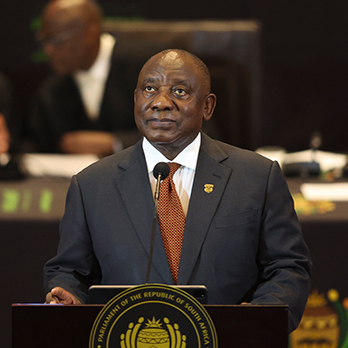President Ramaphosa welcomes constructive engagement with steel sector
President Cyril Ramaphosa met with business leaders in the steel and engineering industries on 18 April 2023 to discuss measures that government, the industry and other social partners will take together to grow the sector and ensure its future sustainability.
President Ramaphosa met with the Steel and Engineering Industries Federation of Southern Africa (SEIFSA) led by Chairperson, Mr Elias Monage, at the Union Buildings in Tshwane. The purpose of the meeting was to deepen engagement between government and this strategic sector of the economy. The meeting was the first direct engagement between a South African Head of State and the sector since SEIFSA’s formation almost 80 years ago.
In the first State of the Nation Address of the 6th Administration, in 2019, President Ramaphosa directed that the sector be given specific focus through the development of a steel and metal fabrication master plan. In June 2021 the Department of Trade, Industry and Competition signed the sector master plan, which provides a blueprint for the industry to revitalise and expand production.
The master plan is a key part of the reimagined industrial strategy which President Ramaphosa has championed to unleash private investment and support inclusive growth.
“The steel sector is at the heart of our economy, as it has a significant multiplier effect and is one of largest job creators in the manufacturing sector. Our infrastructure drive should be the catalyst that propels its recovery and growth. We are determined to build a local steel sector that is strong, competitive and well positioned for the future”, said President Ramaphosa.
The President outlined the actions being taken to achieve energy security, improve the performance of the freight logistics system and tackle corruption and crime, which have received strong support from business leaders. Government and industry representatives discussed opportunities for local steel in the effort to rehabilitate the rail network, expand the national transmission grid and build water infrastructure, as well as the need to invest in skills development.
The SEIFSA leadership expressed its support in working with government and other social partners to address the country’s challenges and unlock investment in the sector.
The lack of qualified Artisans is a constraint to Economic Growth
A functioning economy must have a sufficient number of artisans if it is to fulfill its economic potential. From energy and water to transport and logistics, all key sectors of the economy are dependent on a ready supply of artisans.
Although South Africa remains woefully short of artisan skills, this reality is no stranger to the South African government. In November 2022, the Minister of Higher Education, Science and Innovation Dr. Blade Nzimande warned that South Africa needs at least 60% of school leavers to pursue training in a trade to meet the country’s demand for scarce skills.
Dr. Nzimande at the 2022 Centres of Specialisation (COS) Artisan Graduation Ceremony, stated: “We honestly need to do more to encourage school leavers to pursue technical trades, as government expands technical and vocational education. This is amongst the reasons why there is a continuous need for suitably qualified artisans to sustain industries and support economic growth in South Africa,”
The Department of Home Affairs has also made a concerted effort to attract critical skills to the country by adding seven trades to the latest critical skills list, which was released in August 2022. The inclusion of trades in the critical skills list highlights the shortage of these skills and affords foreign nationals with these skills an opportunity to apply for critical skills work visas.
This may appear contradictory, when considering the country’s unacceptably high levels of unemployment, however, the issue is that these are skills the economy urgently needs and are not readily available locally
The President in the State of the Nation Address in February 2023 sated: “One of the key ingredients for economic growth and competitiveness is the ability to attract skills which the economy needs. Having completed a comprehensive review of the work visa system, we will move quickly to implement the recommendations put forward.”
According to the requirements of the government’s National Development Plan (NDP) and White Paper for Post-School Education and Training, South Africa should be producing 30,000 qualified artisans per year by 2030. This will remain a pipe dream if there is no synergy, strategy and agreed action plan between the main role players to see the Decade of the Artisancampaign being achieved.
South Africa faces two main problems when it comes to the shortage of artisans. Firstly, older experienced artisans who are over the age of 55 are retiring, while those in their 30s and 40s are taking advantage of the global portability and demand for their skills and immigrating. In addition, the 36.5% decline in the total number of learners who enter artisanal learning programmes during the 2020/21 financial year is also a major concern.
Secondly, and compounding the problem further, is that younger newly qualified artisans lack the experience to substitute to the leavers. Moreover, the appalling formal education system produces matriculants who lack the maths and science literacy required to get to grips with the demands of many trade programmes.
This leaves the country with a gap in the market of about 20 years and no pipeline of younger suitably qualified artisans ready to join the workforce, build their careers and contribute to economic growth.
For the country to produce what the National Artisan and Apprenticeship Development Strategy 2030 dubbed as the 21st Century Artisan (A21), there needs to be: a functional system that ensures exposure for learners in artisanal programmes to the theoretical aspect of their trade; simulation (practical) and experiential learning (on-the-job training); and a clear acknowledgment that one or two parts of these components is simply inadequate – all artisans in training need immersion in all these aspects to eventually become A21 Artisans.
For this process to succeed, a strong ongoing partnership between three crucial role players must be mapped, implemented and monitored on an ongoing basis:
- Industry/workplaces;
- Sector Education and Training Authorities (SETAs); and
- Skills Development Providers and reputable Training Centres, such as the SEIFSA Training Centre.
The Government also plays a major overarching role - it needs to be the glue that binds these three important stakeholders together by providing the necessary regulatory and enabling framework.
Zizile Lushaba is Human Capital & Skills Development Executive at the Steel and Engineering Industries Federation of Southern Africa (SEIFSA).


